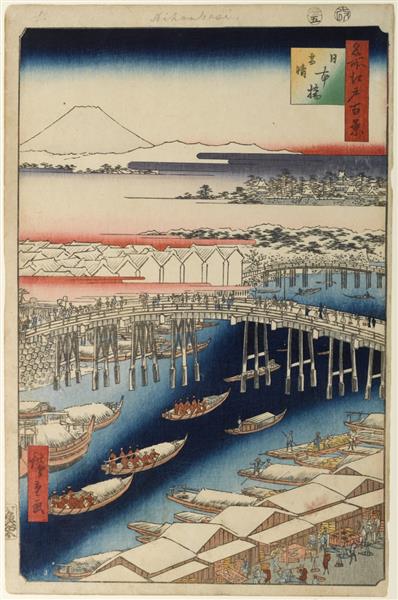Kuvaus
Utagawa Hiroshige's 1857 work "Nihonbashi. Cleaning Up After the Snow" is a sublime example of ukiyo-e, a Japanese style of woodblock print that developed during the Edo period. Part of the "One Hundred Famous Views of Edo" series, this painting captures a fleeting moment when the cityscape of Nihonbashi is revealed after a snowfall. Known for his ability to portray nature and everyday life, Hiroshige transforms a meteorological event into a vibrant scene that invites contemplation.
Compositionally, the work presents a panoramic view of the famous Nihonbashi Bridge, which is central to the image and serves as a visual anchor point. The structure rises gracefully above the river, capturing the importance of architecture in the social and urban fabric of Edo. Snow, here the metaphor for renewal, covers the bridge and the immediate surroundings, suggesting the temporal purity and transience of beauty in nature.
The colours used are predominantly cool, with a palette based on blues and whites, evoking the freshness of the air after a snowfall. However, touches of warm colour can be found in the clothing of some figures and in the trees in the background, which add interest and depth to the work. Hiroshige also exhibits his skill in the application of shadows and lights, creating a sense of three-dimensionality and volume that is characteristic of his work.
The human presence in the painting is subtle but significant. Various figures are seen interacting in the scene; some are dressed in traditional Japanese clothing, multidimensional in design, which adds a sense of life and movement to the composition. These people, though small in comparison to the landscape, reflect the intrinsic connection between humans and their environment, as well as the resilience of everyday life despite the elements.
The work also reveals interesting insights into the culture of 19th-century Japan, where seasonal change was not only a natural but also a cultural phenomenon, celebrated in literature and art. Hiroshige captures this essence by depicting a specific moment that resonates with a deep appreciation for nature and urban life. His style is a testament to the transition from the Edo era to a more modern world, where the understanding of landscape is transformed by a sense of urgency and change.
Hiroshige's skill combines technical mastery with poetic sensitivity. "Nihonbashi. Cleaning Up After the Snow" is intimately linked to the tradition of ukiyo-e, which not only encompasses the beauty of the outside world, but also the transience of the moments we inhabit. In this sense, Hiroshige becomes a visual chronicler of his time, offering a window into the past that still reverberates in contemporary times, emphasizing the need to observe beauty in everyday life, even after a storm.
KUADROS ©, a famous painting on your wall.
Hand-made oil painting reproductions, with the quality of professional artists and the distinctive seal of KUADROS ©.
Painting reproduction service with satisfaction guarantee. If you are not completely satisfied with the replica of your painting, we will refund 100% of your money.

